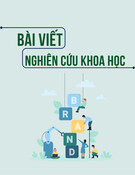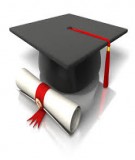
JOURNAL OF SCIENCE AND TECHNOLOGY DONG NAI TECHNOLOGY UNIVERSITY
316
Special Issue
ASSESSING STUDENTS’ SELF-LEARNING ABILITY: A CASE
STUDY AT THU DUC COLLEGE OF TECHNOLOGY
Thu Ngoc Anh Huynh1, Hung Tri Tang2, Thien Huu Nguyen2*
1Thu Duc College Of Technology
2Dong Nai Technology University
*Corresponding author: Thien Huu Nguyen, nguyenhuuthien@dntu.edu.vn
GENERAL INFORMATION
ABSTRACT
Received date: 25/03/2024
This research examines the self-learning capabilities of
students at Thu Duc College of Technology, specifically those
majoring in Finance and Accounting, in the context of the
Industrial Revolution 4.0. This study aimed to provide
recommendations for improving the quality of student
education and training. Quantitative research methods and
regression analyses were employed using data collected from
201 students majoring in Finance and Accounting. The results
revealed that five factors: Ability to set goals and plan for
learning; Learning environment and methods; Ability to
recognize and solve problems; Difficulties in the learning
process; and Self-assessment of your process influenced
students’ self-learning abilities. These findings contribute to a
better understanding of students’ self-learning capabilities and
offer practical implications for fostering independent thinking,
creativity, and innovation in higher education, particularly in
Finance and Accounting.
Revised date: 18/05/2024
Accepted date: 25/07/2024
KEYWORD
Ability to study independently;
Formative Assessment;
Self-learning;
Self-learning ability;
Self-learning Method.
1. INTRODUCTION
The main goal of higher education – college–
has always been to train high-quality human
resources, improve personal knowledge, and
nurture talent (Adeoye, 2024). At the heart of this
pursuit is the role of scientific and technological
research in the creation of new knowledge, an
aspect that is particularly relevant for students
majoring in Finance and Accounting, for whom
keeping up with advances is crucial (Maiya &
Aithal, 2023). Therefore, focusing on fostering self-
study skills is urgent to support students in
achieving this goal.
The Education Law No. 43/2019/QH14 also
emphasizes the need for educational methods that
encourage learners’ initiative, self-discipline, and
creative thinking. The development of self-learning
abilities is an important requirement for meeting the
goals set by this law. Encourage self-directed
learning in line with the overarching goal of forming
well-rounded individuals capable of independent
thinking and innovation (Adeoye, 2024; Orn, 2022).
The advent of Industrial Revolution 4.0, has
also ushered in transformative changes in many
different social sectors, especially in education. The
integration of technology and improvement of
students’ self-learning abilities are urgent
requirements for effective adaptation to the digital














